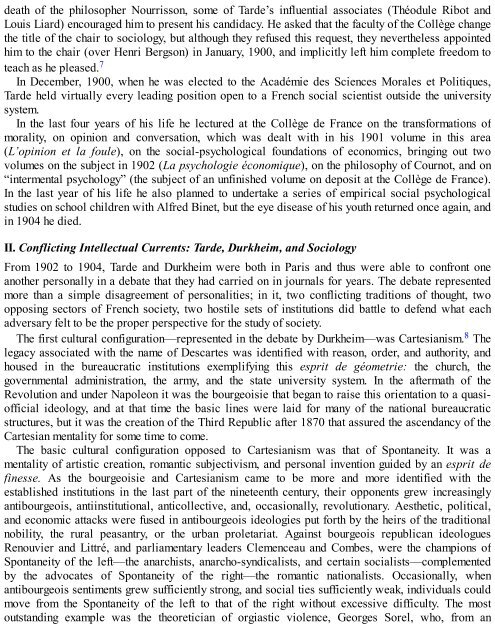3658925934
Create successful ePaper yourself
Turn your PDF publications into a flip-book with our unique Google optimized e-Paper software.
death of the philosopher Nourrisson, some of Tarde’s influential associates (Théodule Ribot and<br />
Louis Liard) encouraged him to present his candidacy. He asked that the faculty of the Collège change<br />
the title of the chair to sociology, but although they refused this request, they nevertheless appointed<br />
him to the chair (over Henri Bergson) in January, 1900, and implicitly left him complete freedom to<br />
teach as he pleased. 7<br />
In December, 1900, when he was elected to the Académie des Sciences Morales et Politiques,<br />
Tarde held virtually every leading position open to a French social scientist outside the university<br />
system.<br />
In the last four years of his life he lectured at the Collège de France on the transformations of<br />
morality, on opinion and conversation, which was dealt with in his 1901 volume in this area<br />
(L’opinion et la foule), on the social-psychological foundations of economics, bringing out two<br />
volumes on the subject in 1902 (La psychologie économique), on the philosophy of Cournot, and on<br />
“intermental psychology” (the subject of an unfinished volume on deposit at the Collège de France).<br />
In the last year of his life he also planned to undertake a series of empirical social psychological<br />
studies on school children with Alfred Binet, but the eye disease of his youth returned once again, and<br />
in 1904 he died.<br />
II. Conflicting Intellectual Currents: Tarde, Durkheim, and Sociology<br />
From 1902 to 1904, Tarde and Durkheim were both in Paris and thus were able to confront one<br />
another personally in a debate that they had carried on in journals for years. The debate represented<br />
more than a simple disagreement of personalities; in it, two conflicting traditions of thought, two<br />
opposing sectors of French society, two hostile sets of institutions did battle to defend what each<br />
adversary felt to be the proper perspective for the study of society.<br />
The first cultural configuration—represented in the debate by Durkheim—was Cartesianism. 8 The<br />
legacy associated with the name of Descartes was identified with reason, order, and authority, and<br />
housed in the bureaucratic institutions exemplifying this esprit de géometrie: the church, the<br />
governmental administration, the army, and the state university system. In the aftermath of the<br />
Revolution and under Napoleon it was the bourgeoisie that began to raise this orientation to a quasiofficial<br />
ideology, and at that time the basic lines were laid for many of the national bureaucratic<br />
structures, but it was the creation of the Third Republic after 1870 that assured the ascendancy of the<br />
Cartesian mentality for some time to come.<br />
The basic cultural configuration opposed to Cartesianism was that of Spontaneity. It was a<br />
mentality of artistic creation, romantic subjectivism, and personal invention guided by an esprit de<br />
finesse. As the bourgeoisie and Cartesianism came to be more and more identified with the<br />
established institutions in the last part of the nineteenth century, their opponents grew increasingly<br />
antibourgeois, antiinstitutional, anticollective, and, occasionally, revolutionary. Aesthetic, political,<br />
and economic attacks were fused in antibourgeois ideologies put forth by the heirs of the traditional<br />
nobility, the rural peasantry, or the urban proletariat. Against bourgeois republican ideologues<br />
Renouvier and Littré, and parliamentary leaders Clemenceau and Combes, were the champions of<br />
Spontaneity of the left—the anarchists, anarcho-syndicalists, and certain socialists—complemented<br />
by the advocates of Spontaneity of the right—the romantic nationalists. Occasionally, when<br />
antibourgeois sentiments grew sufficiently strong, and social ties sufficiently weak, individuals could<br />
move from the Spontaneity of the left to that of the right without excessive difficulty. The most<br />
outstanding example was the theoretician of orgiastic violence, Georges Sorel, who, from an









![Genki - An Integrated Course in Elementary Japanese II [Second Edition] (2011), WITH PDF BOOKMARKS!](https://img.yumpu.com/58322134/1/180x260/genki-an-integrated-course-in-elementary-japanese-ii-second-edition-2011-with-pdf-bookmarks.jpg?quality=85)
![Genki - An Integrated Course in Elementary Japanese I [Second Edition] (2011), WITH PDF BOOKMARKS!](https://img.yumpu.com/58322120/1/182x260/genki-an-integrated-course-in-elementary-japanese-i-second-edition-2011-with-pdf-bookmarks.jpg?quality=85)





